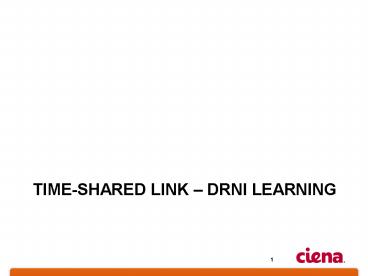TIME-SHARED LINK - PowerPoint PPT Presentation
Title:
TIME-SHARED LINK
Description:
... eliminate the IPL / Network Link timeshare mode. impose topology restrictions associated with the use of the IPL / Network Link timeshare mode e.g. only p2p ... – PowerPoint PPT presentation
Number of Views:27
Avg rating:3.0/5.0
Title: TIME-SHARED LINK
1
TIME-SHARED LINK DRNI LEARNING
2
From axbq-haddock-intra-das-link-0711-v02.pdf
the use case we are considering
- The difference between case 2a and 2b is that
there is no predetermined link selection. - When transmitting to the DRNI this means the link
selected is on the first DRNI node encountered by
the frame. In terms of gateway selection this
means a DRNI node is the gateway for any frame
received on any link that is not directly
connected to the other DRNI node. - When receiving from the DRNI node that receives
the frame is also the gateway for that frame.
3
From axbq-haddock-intra-das-link-0711-v02.pdf-
The Steady State Problem
- Every frame of the A ? Z conversation is
propagated on-net, and also along the B ? C link,
thence to X where it is discarded (2nd Gateway) - Every frame of the Z ? A conversation is
propagated on-net, and also along the Y ? X link,
thence to C where it is discarded (2nd Gateway) - Net-net, the entire A?C conversation gets
replicated on the IPL / Network Link of the
remote network to no purpose.
4
axbq-haddock-intra-das-link-0711-v02.pdfSo what ?
- Mitigation possibilities include (in no
particular order) - eliminate the IPL / Network Link timeshare mode.
- impose topology restrictions associated with the
use of the IPL / Network Link timeshare mode - e.g. only p2p service between over DRNI is
supported in this mode - no MAC learning needed, simple VLAN forwarding
rules just work - others ?
- re-visit MAC learning synchronisation
- Exchange MACs learned from DRNI enables
Gateways to learn unicast routes for all
conversations. - there must be others ?
5
From axbq-haddock-intra-das-link-0711-v02.pdf-
Step 2 the problem summary
- Learning phase 2
- Y propagates Zs reply on learned route (via B),
- it must also replicate it to the DRNI (towards
X), because the route could originate at S (top
L), and Y is 1st Gateway for route to S - To solve this, B must communicate to Y whence the
original packet with SA A came.
6
From axbq-haddock-intra-das-link-0711-v02.pdf -
a possible solution.
- A simple solution would be to use a modified MAC
learning process - When B learns a source MAC in the normal way on
any non-IPL link, - it unicasts a control packet (?) on the IPL only,
qualifying the source - as on-net, from-DRNI, local-time-out,
unknown , - which is used to modify the attributes of the SA
MAC also learned at Y by normal mechanisms (so
MAC aging is handled by normal means). - This MAC source communication does not need to be
totally reliable - a lost packet results only in inefficiency, not
failure (see slide 3), - but transmission x 3 on first learning a MAC
would be sensible, - and repeating the MAC source qualification packet
at infrequent intervals(e.g. MAC age-out time /
3 ?) will ensure sync in long term
7
REPRESENTING THE RELATIONSHIP BETWEEN DRNI (MASK)
VARIABLES
8
Trying to make sense of the Conversation-sensitive
frame collection and distributionVariables
Port Algorithm TLV
Port Conv ID Digest TLV
aAggConversationAdminPort
Conversation Mask TLV
Port Conv Svc Map TLV
Service ID
? Conversation-sensitive LACP
aAggAdminServiceConvMap
per port ? aggregate
Collection_Conv_Mask
Port Conversation ID
?
Actor_Oper_Port_State.Dist
updateConversationMask
per port ? aggregate
Comp_Oper_Conv_Mask
receivedConversationMaskTLV
? updateConversationMask
?
?
Port_Oper_Conv_Mask
Partner_Oper_Conv_Mask
Per Agg. Port Variables
Per Aggregator Variables
Per Aggregator Attributes































